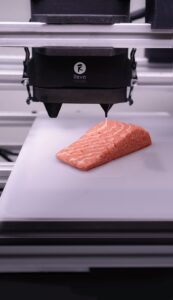Unveiling the Art of Three-Dimensional (3D) Printed Food
Last Updated on July 28, 2024
Three-dimensional (3D) printed foods are real-life edible foods generated from a computer-aided design. This type of food processing uses additive manufacturing, where layers of food-safe ingredients are stacked to achieve a particular food structure. A printer deposits the food material layer by layer according to the computer-aided design. Oftentimes, these include using accessories such as nozzles, lights and lasers to aid the layering of materials and speed of the process.
3D printing is revolutionary and has a plethora of applications, benefits, drawbacks, and potential for research that promises to advance food technology.
Where Is It Used?
There are many potential applications for 3D-printed foods, and some have already appeared in the mainstream. For example, some fine-dining restaurants have used this technology to produce intricate works of art to serve with the meal’s main course.
Alternatively, some bakeries use 3D printers to create sugar or chocolate shapes for custom orders. A 3D printer has been developed that can produce 3D-printed pizza. However, the company responsible for this innovation has now redirected its attention to creating food items using plastics. Beyond restaurants and food establishments, 3D printing holds promise for diverse applications, including military, space exploration, and improving the quality of life in retirement homes for the elderly.

ChefJet Candy 3D Printer
Maurizio Pesce from Milan, Italia, CC BY 2.0 https://creativecommons.org/licenses/by/2.0, via Wikimedia Commons
Methods and Examples
Two primary methods are commonly employed in 3D food printing. The first method, known as material extrusion, creates foods through purée inputs in bottles that stack each layer of the food. This method is particularly suitable for malleable foods like chocolate, pasta dough and mousses.
Another method involves inkjet printing, which uses droplets to create solid particle layers that combine to form a liquid substance. When the thermal head is heated, pressure is created, causing the liquid substance to break into droplets. Consequently, these droplets can be rearranged like puzzle pieces to create various designs on cookies and pastries.
Development
Typically, these printers do not cook the food but instead print intricate shapes and designs. However, a few types of prototype 3D printers can directly cook food. 3D food printing involves both pre-processing and post-processing steps. Pre-processing steps involve altering ingredients to meet specific printing process requirements such as adjusting texture and consistency to match the printing requirements. Post-processing modifies the printed structure to refine the taste, often involving steps like baking, cooking or adding finishing touches.
Materials Used in 3D Printing: Carbohydrate Nutritional Use
Carbohydrates can be used as a printing material in 3D printing. Maltitol, for example, can be used as a healthier alternative to traditional sucrose in chocolate. This substitution lowers the risk of obesity because it produces sugar-free chocolate and exhibits health benefits that help to prevent tumours and delay senescence. In addition, pectin, a hydrocolloid, serves as a gelling agent for printed foods. Pectin’s nutritional benefits help with cholesterol metabolism and treatment against intestinal infections and cancer.
Materials Used in 3D Printing: Protein Nutritional Use
Pea proteins exemplify a useful application for enhancing the nutritional value of starch-based ink printing. Proteins are essential to help with stability and form the foundation of the food product’s structure. Its ability to form bond linkages is attributed to its hydrophobicity and also a lipid-like structure substitute. Consequently, providing benefits to decrease the risk of high saturated fat content in foods to lower the risk of atherosclerosis development.
Pros and Cons

3D printing has various advantages, but it also has certain drawbacks that must be considered. Here are some of the pros and cons associated with 3D printing.
Pros
- Personalized nutrition planner: Tailors foods with the correct mouth feel, flavours and texture to align with consumer wants. For example, gel printers produce soft foods for easy swallowing in the elderly population.
- Complex culinary presentation: Effortlessly produces intricate geometric shapes, automating laborious steps like shaping and dicing ingredients into desired formations in just one simple step.
- Consistency and Precision: Provides consistency and precise replication
- Food packaging: Develops customization packability, ability to reuse plastics and fabricate biopolymers for packaging prototypes.
Cons
- Lack of materials: Functional macromolecules are still in research and have not yet been commercialized for consumer products.
- High costs: The average prototyping cost can range from $10,000 to $500,000, making it very expensive.
- Long processing time: Limits the effectiveness and places demands on companies to meet consumer demands.
Challenges and Future Development
The potential of 3D printing technology to revolutionize the food industry is hindered by challenges such as improving equipment precision, printing speed, and functional macromolecules. The increasing demand for plant-based animal textures will drive the technology forward as producers strive to create bio-printed meats, reducing their carbon footprint. Companies like Revo Foods harness 3D printing to craft plant-based fish fillets, while cellular agriculture is prototyping printed scaffolds and cellular inkjet techniques to sustainably replicate meat products. These advancements promise to address environmental concerns and meet the growing global demand for food.
Conclusion
Overall, 3D printing encourages accelerated development in enhancing food presentation with its diverse selection of foods and nutritional benefits. As more ethical and environmentally friendly meats are rising startups, the future food supply will change to match consumer wants. It is coupled with the advantages of customizable and selective food preparation. Then again, the potential disadvantage would be the unfeasible operations. With the growth of food engineering on the rise, only time will determine the food industry’s innovation.

About the Author: Hi! I am Bertina Do, a first-year food science student attending the University of Guelph. I have a fascination with food chemistry and molecular gastronomy.


leave your comment